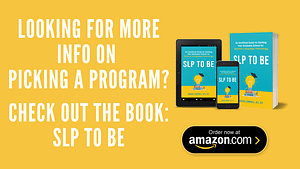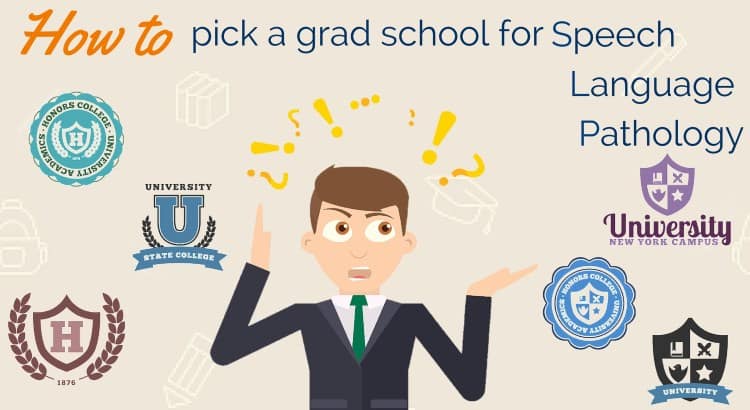If you’re considering graduate school for speech-language pathology, you know there are so many options! You’re probably feeling a little overwhelmed (or if you’re me, completely overwhelmed), at the thought of sorting through all of those options.
Don’t worry.
In this post, I’m going to walk you through how to pick a grad school for speech-language pathology and the exact process that I used to identify programs where you can get in.
Also, you can see the info sheets I created to keep track of each school and the application.
1. Set Your Criteria
To begin, you need to know what is important to you.
Maybe you’re looking for a program in your geographic area. Maybe you want a program with a bilingual emphasis option. Whatever it is, make a list of the most important criteria for you in an SLP program AND in a graduate school.
Below are some things to think about. Select two to three of the most important factors to you.
-
Geographic Area
Do you want to be in a certain state? Big city? Small town? Generally, graduate school is a national market and searching broad will boost your chances. But if you have a family or other constraints, it is okay to stay local.
-
Required Pre-Requsiites
Even if you have a bachelor's degree in CSD, check the specific pre-reqs required for admission for a certain university. If you're an out-of-field candidate, this is an especially important thing to consider.
-
State Licensure
If you know you want to work in Minnesota, going to school there will help you obtain your license for that state. That said, obtaining licensure in another state is generally pretty easy. Don't let this deter you from accepting a better offer in another state.
-
University Size
Big, medium, or small? Personally, I went to a small school for undergrad so I wanted a larger one with more resources for my graduate degree. There are pros and cons to each; it ultimately comes down to preference.
-
Program Size
In graduate school, you're mostly in your own little world within your department. So, consider the size of the SLP program as a whole, no just the university.
-
Research Opportunities
If you want to specialize in an area, getting some research in that subject is helpful. Is there a researcher or lab at that school focused on your interest? If you want to go broad, that's okay too!
-
Degree Type
Do you want to be a clinician and work as an SLP? Then make sure you go to a school that will help you eventually earn you CCC. It should be accredited be an ASHA accredited program.
-
Emphasis / Specialty
If you’re one of those lucky few who already know what you like, find a school that specializes in that. Some schools specialize in medical SLP or others have programs for Bilingual SLP’s (like me!). Most programs follow the same broad guidelines to meet accreditation. Speciality training is likely in the form of "extra" classes (extra time and money too!).
-
Traditional / Online / Hybrid
If you can’t make it to a traditional classroom everyday because you’re working or you have kids, consider an online program or even a hybrid. The availability and quality of online and hybrid programs is shifting massively in response to the COVID pandemic.
-
Full-Time vs Part-Time
Some programs require full-time attendance while others let you work through the requirements at a slower pace.
-
Study Abroad
Is it important to you to study in another country during grad school? I had that chance at the University of New Mexico, and many other universities offer programs as well.
2. Rank Those Criteria
Once you’ve selected a few things that you’re looking for, you need to decide which factors are most important to you.
I recommend picking just one or two. Maybe you’ll be lucky enough to find a program that has everything you want, but the chances are slim. It is important to keep an open mind.
Anecdote: When I was a senior in high school, I was 100% sure I was going to this one university for college. No doubts. One morning I was in Physics class (not particularly wanting to be there), and an announcement came on the PA system announcing there was a representative from Truman State University in the counseling office to visit with any interested seniors. I was much more interested in anything other physics, so I went to the presentation. Long-story made short: I fell in love with Truman State; I ending up going there and it completely changed my life. Moral of the story? Keep an open mind…and don’t be afraid to skip physics class
Personally, I used two criteria:.
- First, I wanted a program that offered training in bilingual and multicultural issues. So I automatically crossed off any schools that didn’t advertise this option.
- Second, I needed a school that offered an extended program for out-of-field candidates.
3. ASHA EdFind
Once you know what you’re looking for, visit ASHA’s EdFind.
On the left, you’ll notice the option to check off different criteria that you’re interested in. EdFind has a lot of options, but not everything. If there is something important to you that you don’t see listed, you’ll research it more later.
Click your criteria and get the big list. If the list is too long, try adding more criteria to narrow it down further.
Once you have the giant list in front of you, I recommend opening up an Excel document (or Google Sheets; its free) and making a list of each school. Just start with their name.
When I did this, I had around 70 schools on my first round list.yo
4. Narrow it Down Through Research
Now that you’ve got a big list, you’ll want to narrow it down even further. I hope you’re not tired yet, because this is where the real work begins.
What you’ve got to do know is look up each individual school and get details. If your list is long, you’ll have to paint with a broad brush during this first round of research. Try google searching the name of the university + SLP (e.g., “University of New Mexico SLP”) and that should get you pretty close to their departmental website.
Start by verifying the schools meet your criteria (in my case: Bilingual & 3-Year Masters). EdFind has improved a lot since I first used it back in 2015, but it is still occasionally wrong or outdated. If the program doesn’t meet your criteria, cross it off your list.
It is okay to go through the list 2-3 times, each time being a bit pickier about what you want.
Once you’re down to maybe 10-20 schools, you’re getting close to the next step.
5. Reach out and talk to people
As you’re investigating schools, there is only so much information that you can glean from websites. Besides that, websites can’t tell you much about the personality of the program.
There are two major groups of people you should talk to during your research: Faculty and Alumni
For this, I created a worksheet for each school where I started collecting all of the important information about it.
You can check out the Excel or the Word.doc versions on my downloads page: Free Tools.
Faculty is usually in two parts: academic and clinical. Academic faculty are your professors (usually PhD’s) who teach classes and do research. Clinical faculty are clinicians (with CCC-SLP) who supervise you as you practice with clients.
Both are people and they have their own unique ways of working and being. You want to know if they’re people you’re going to feel comfortable working with for at least two years.
First, try and go through the admissions office or department coordinator to get in touch with a professor. If that doesn’t work, see if their email address is listed on the faculty page. Remember, they’re busy professionals, so try to be clear and concise with your questions.
Side note: Just because professors are busy, doesn’t mean they get to be rude. When I was doing research, I had a few professors who flat out said things like “I don’t have time for this” or “This isn’t my job, you’ll need to talk to someone else.” So I crossed those schools off my list. Why would I want to work with someone who is unpleasant?
Alumni are pretty easy to get in touch with through social medial, and they have all the best information! Try joining some SLP groups or following the #hastags (#slpeeps or #slp2b) on twitter and you’ll find people are pretty friendly, and willing to talk.
6. Think about cost
College is expensive. Everyone has their own opinion on student loans and such, and sine you’re here on my blog, I’ll share mine:
Go to the program that will get you your degree and CCC with as little debt as possible.
That advice was given to me in my search, and now that I’m practicing I very much appreciate not being saddled with insane amounts of doubt.
Anecdote: When I was researching grad schools, I did some shadowing of SLP’s at a hospital. They were wonderful professionals. While chatting with them over the few weeks I was there, I learned they all went to different grad programs (ranging from top 3 schools to ‘no-name’ small schools). And you know what? They all worked in the same place , doing the same job, for probably roughly the same salary. For me, that was something I thought a lot about when deciding whether or not an extra $50,000-$100,000 of loan debt would be worth it.
As long as you earn your degree and your license, you’ll be eligible to compete for all the best jobs in any setting you want. Getting that job will depend a lot more on you and your skills than where you earned your degree.
7. Rank The Schools
Once you’ve got all the information you think you need, you’ll want to start ranking schools. This is probably one of the toughest parts of the process.
Even if you only plan to apply to 2-3, it is not a bad idea to rank more. You never know when your situation or plans might change, and it is nice to have more options available.
I ranked 9 schools and applied to 6. I tried to include a mix of “dream schools” and “realistic options.”
A word of caution here: SLP programs are very competitive and there’s really no such thing as a safety school.

Phew! Ready to apply? Not yet...
Now that you know which programs you’re interested in, it is time to understand their admissions requirements, get to work on your essays, and plan how you’re going to manage all of your applications.


